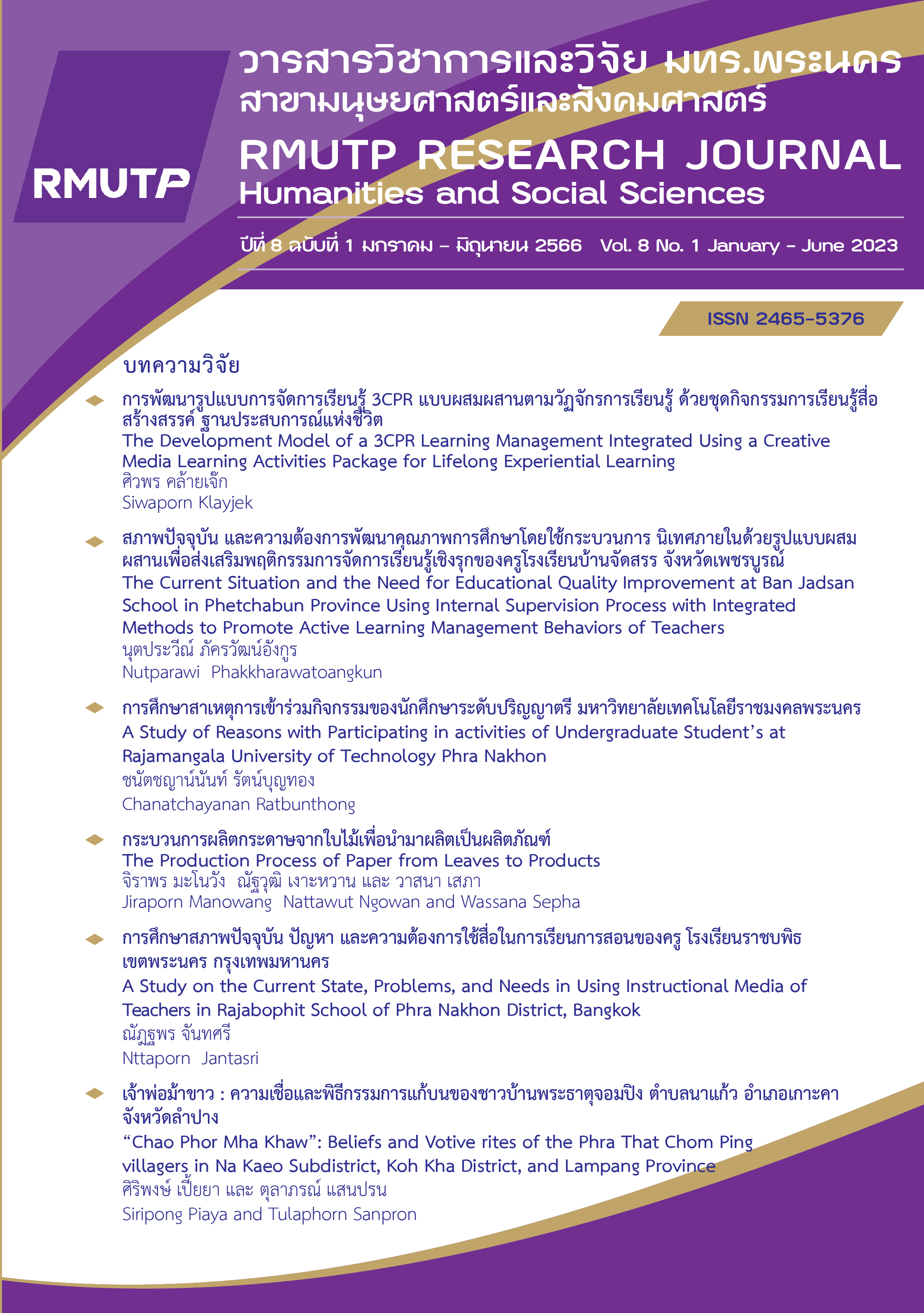The Development Model of a 3CPR Learning Management Integrated Using a Creative Media Learning Activities Package for Lifelong Experiential Learning
Main Article Content
Abstract
The objectives of the study were to create a model of 3CPR learning management that was integrated into the learning cycle with a bundle of creative media learning activities for life-long learning and to judge the model's applicability. Seven specialists conducted the research and development for the assessors who developed the model and determined the model's applicability. The statistics used to analyze the collected data were average () and standard deviation (S.D). The findings revealed that: 1) The Blended Learning 3 CPR Based-on 7Es Learning Cycle Model was established and consisted of seven elements: (1) Elicitation; (2) Engagement; (3) Exploration; (4) Explanation; (5) Expansion; (6) Evaluation and (7) Extension. 2) The 3CPR Learning Management Integrated Model Life experiencing learning was appropriate at the highest level, according to the Learning Cycle using a Creative Media Learning Activities Package.
Article Details
References
ถนอมพร เลาหจรัสแสง. (2541). คอมพิวเตอร์ช่วยสอน. กรุงเทพฯ: ศูนย์หนังสือแห่งจุฬาลงกรณ์มหาวิทยาลัย.
ทรงสิริ วิชิรานนท์ อรุณี อรุณเรือง นิตินันท์ ศรีสุวรรณ และสุนันทา ชูตินันท์. (2561). ความต้องการจำเป็นในการจัดสภาพแวดล้อมที่เอื้อต่อการพัฒนาการเรียนรู้ทางนักศึกษามหาวิทยาลัยเทคโนโลยีราชมงคลพระนคร. วารสารวิชาการและวิจัย มทร.พระนคร สาขามนุษย์ศาสตร์และสังคมศาสตร์, 3(1), 75-86.
ธานินทร์ อินทรวิเศษ และคณะ. (2562). เทคโนโลยีและนวัตกรรมกับการจัดการเรียนการสอนในยุคดิจิทัล. Veridian E-Journal, Silpakorn University Humanities, Social Sciences and art, 12(6), 478-494.
บุญชม ศรีสะอาด. (2535). หลักการวิจัยเบื้องต้น. (พิมพ์ครั้งที่ 3) กรุงเทพฯ: สุวีริยาสาสน.
ประทวน คล้ายศรี. (2559). การพัฒนารูปแบบการเรียนการสอนโดยใช้แนวคิดการเรียนรู้แบบผสมผสานร่วมกับแนวคิดอภิปัญญาสำหรับนักศึกษา คณะครุศาสตร์มหาวิทยาลัยราชภัฏในภาคตะวันออกเฉียงเหนือ.วิทยานิพนธ์ตามหลักสูตรศึกษาศาสตรดุษฎีบัณฑิต มหาวิทยาลัยธุรกิจบัณฑิตย์.
ไพฑูรย์ กานต์ธัญลักษณ์. (2557). การพัฒนารูปแบบการเรียนการสอนแบบผสมผสานด้วยการเรียนแก้ปัญหาร่วมกันและเทคนิคซินเนคติกส์เพื่อส่งเสริมความสามารถในการแก้ปัญหาเชิงสร้างสรรค์ของนักศึกษาครู. วิทยานิพนธ์ปรัชญาดุษฎีบัณฑิต มหาวิทยาลัยศิลปากร. นครปฐม
วราภรณ์ มิ่งเมือง. (2560). การพัฒนาชุดกิจกรรมการเรียนรู้แบบวัฏจักรการสืบเสาะหาความรู้ 7 ขั้น เรื่อง การถ่ายทอดลักษณะทางพันธุกรรม สำหรับนักเรียนชั้นมัธยมศึกษาปีที่ 4. สืบค้นจาก https://www.pks.ac.th/news/pks_09072560235.html
วิชุดา มาลาสาย. (2561). การพัฒนารูปแบบการการเรียนการสอนเพื่อเสริมสร้างความสามารถในการแก้ปัญหาอย่างสร้างสรรค์ทางคณิตศาสตร์ของนักเรียนชั้นมัธยมศึกษาปีที่ 6 โรงเรียนสว่างแดนดิน. รายงานวิจัยฉบับสมบูรณ์ สำนักงานคณะกรรมการการศึกษาขั้นพื้นฐาน กระทรวงศึกษาธิการในโครงการวิจัยและพัฒนานวัตกรรมแลกเป้า สพฐ.
สำนักงานเลขาธิการสภาการศึกษา. (2552). ข้อเสนอการปฏิรูปการศึกษาในศตวรรษที่สอง (พ.ศ. 2552-2561). กรุงเทพฯ: พริกหวานกราฟิก.
LearnEducation. (2560). Blended learning การเรียนแบบผสมผสาน ตอบโจทย์ยุค New Normal. สืบค้นจาก https://www.learneducation.co.th/blended-learning/
Anderson, T. P. (1997). Using models of instruction. In C. R. Dills, & A. J. Romiszowski (Eds), Instructional development paradigms. Englewood Cliffs, NJ: Educational Technology Publications.
Duke, Daniel, L. (2004). The Challenges of Educational Change. Pearson Education, Inc.
Eisenkraft, A. (2003). Expanding the 5E model: A proposed 7E model emphasizes “transfer of learning” and the importance of eliciting prior understanding. [Teacher Practitioner]. The Science Teacher, 70, 56-59.
Kibler, R. J. (1970). Behavioral objective and instructional process. In Milton Muse (Ed.), Selected reading for the introduction to the teaching profession, p. 44-53.


